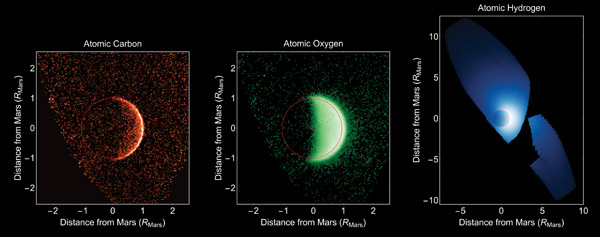
by Timothy Oleson Tuesday, December 9, 2014

Within days of arriving at Mars, MAVEN mapped carbon, oxygen and hydrogen in the planet's upper atmosphere with the help of its Imaging Ultraviolet Spectrograph instrument. Credit: University of Colorado/NASA.
As two rovers patrol the surface of Mars, five spacecraft orbit above and scientists back here on Earth study the Red Planet from afar, new findings are announced almost weekly. Here are a few of the latest updates.
Within days of arriving in orbit around Mars on Sept. 21, NASA’s Mars Atmosphere and Volatile Evolution (MAVEN) spacecraft was already at work on its mission to look for clues as to why the planet lost so much of its once-thick atmosphere. On Sept. 29, the orbiter observed a burst of high-speed solar energetic particles (SEPs) from a solar coronal mass ejection showering the planet; SEPs energize molecules and atoms in the atmosphere, potentially easing their escape from Mars’ gravitational pull. MAVEN also collected impressive images of carbon, oxygen and hydrogen in the planet’s upper atmosphere, the study of which supports “our current understanding that the upper atmosphere of Mars … is only tenuously bound by the Red Planet’s weak gravity,” said MAVEN team member Mike Chaffin of the University of Colorado at Boulder in a statement.
Comet Siding Spring made a close flyby of Mars on Oct. 19, passing about 132,000 kilometers — or less than half the distance between Earth and the moon — from the Red Planet. The comet originated in the swarm of ancient, icy bodies orbiting the sun beyond the solar system known as the Oort Cloud. The flyby offered the first opportunity to observe an Oort Cloud object up close. All five Mars orbiters were maneuvered to avoid the wake of dust and debris trailing the comet, although each was still able to spy on Siding Spring. Early indications from the High Resolution Imaging Science Experiment (HiRISE) aboard the Mars Reconnaissance Orbiter (MRO) suggested the comet’s nucleus is relatively small, with a diameter likely less than half the earlier estimate of 1 kilometer.
Observations of the sulfate mineral jarosite — formed in acidic and watery environments — on the wall of Mars’ Valles Marineris, the largest-known canyon in the solar system, support the notion that glaciers once flowed through the canyon. Selby Cull of Bryn Mawr College in Pennsylvania and colleagues identified a new jarosite deposit on the wall of Ius Chasma in Valles Marineris using data from the Compact Reconnaissance Imaging Spectrometer for Mars instrument aboard MRO. Jarosite found elsewhere on Mars is thought to have mineralized from evaporating pools of groundwater, but based on the position of the new deposit, the researchers reported in Geology that it formed with the aid of sulfate-rich meltwater at the sun-warmed edge of a glacier near the rock wall. A similar mechanism has previously been documented occurring at the margins of glaciers on Svalbard, Norway.
Dunes and dust storms have long offered evidence of wind on Mars’ surface. But scientists have thought that winds strong enough to pick up and transport Martian sands should be rare — perhaps limited to occasional strong storms. Images collected by HiRISE over the Nili Patera dune field over the course of a Martian year, however, showed sand ripples on the dunes’ surfaces migrating on a daily basis in alignment with prevailing winds, according to a study in Nature Communications. The amount of movement was also strongly seasonal, with more migration occurring in the Northern Hemisphere winter than summer, Francois Ayoub of Caltech and colleagues reported. From the observations, the researchers established a threshold wind strength needed to pick up and transport sand at Nili Patera, which should help refine atmospheric models of Mars, they noted.
© 2008-2021. All rights reserved. Any copying, redistribution or retransmission of any of the contents of this service without the expressed written permission of the American Geosciences Institute is expressly prohibited. Click here for all copyright requests.